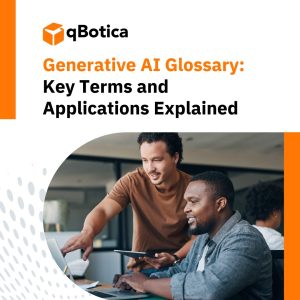The next big thing in document processing isn’t simply about automating tasks; it’s centered around complete transformation. As AI relentlessly pushes its boundaries, a fusion of human intellect and artificial intelligence is progressively altering how we do business with documents.
Remember the good old days when everything was manually handled? Now, thanks to Intelligent Document Processing (IDP), we’ve transcended those traditions. The progression of document processing is steeped in tech-driven improvements that have massively shifted how businesses manage data on paper or otherwise.
This article will take you down memory lane, chronicling the rise and evolution of document handling leading up to the advent of IDP – uncovering just how crucial this has been to the modern corporate world.
The History of Document Processing
Document processing has roots that reach back to the dawn of human civilization when people tracked their affairs using mud slates and scrolls. But it wasn’t until Edwin Sebels dreamed up the filing cabinet in the late 19th century that document management started to take form.
His genius contraption was a godsend for sorting and fetching documents, making it an invaluable tool for medical, legal, and financial wizards alike. Then along came computers and early automation gadgetry that reshaped how we manage documents top to bottom – cue entrance: Intelligent Document Processing (IDP).
The evolution of IDP has been remarkable, from simple Optical Character Recognition (OCR) traps all the way to cutting-edge AI-driven set-ups today that read between lines, learn on-the-go with machine learning flair, and wrangle all sorts of document types with ease.
The Rise of Intelligent Document Processing (IDP)
The emergence of Intelligent Document Processing (IDP) has been a transformative journey driven by speedy tech advancements and soaring demand for streamlined document management. As businesses entered the digital era, they quickly saw the need to ditch slow, error-prone methods in favor of more efficient tech-empowered techniques – cueing the seismic shift in document processing practices.
IDP harnesses artificial intelligence, machine learning, and natural language processing to read, label, and process messy, unstructured data found within documents – that’s a massive leap from good old manual-driven ways.
The journey towards adopting IDP is propelling fast due to the exponential surge in digitized docs, necessitating smooth-as-butter handling and beckoning inventive solutions that can streamline operational wheels.
Benefits of AI-Driven Automation
Harnessing AI-driven automation can bring a host of perks to businesses, including boosted productivity, efficiency ramp-up, enriched user experience, and the unlocking of profound insights. Let’s take a closer look at some key upsides:
- Increased productivity and efficiency – AI-fueled automation empowers businesses to accomplish tasks swifter and with heightened accuracy – freeing up human resources for more strategic and inventive endeavors.
- Reduced costs – By bidding adieu to manual tasks in favor of automated sequences along with process optimization, businesses can witness significant declines in costs, and operational outlays through the wonder that is AI-orchestrated automation.
- Improved user experience – Your customers stand to enjoy snappier outcomes underscored by impeccable precision afforded by AI-backed automation – all aiding in soaring customer contentment levels.
- Access to better insights – The capacity of AI-powered automation stretches as far as delving into vast data tapestries – unearthing precious nuggets of insight that aid decision-making processes for business gladiators on their path toward success.
- Streamlined document processing – AI-fueled automation could completely change the game when it comes to document processing by performing tasks like data extraction, validation, and sorting autonomously. This leads to less room for error and a more efficient operation.
- Improved accuracy and reduced errors – Document processing systems powered with AI can achieve super impressive accuracy rates; over 99%! That’s quite a notch above what traditional human-operated methods bring to the table.
The Future of Document Processing Leveraging AI
We’re witnessing rapid strides in how businesses operate, thanks to the evolving sphere of document processing with artificial intelligence at its core. It won’t be long before we see these systems working hand-in-hand with other techs like Optical Character Recognition (OCR), machine learning, and Natural Language Processing (NLP) aimed at enhancing decision-making processes further down the line.
Here are some potential sub-topics warranting an in-depth review:
1. Cloud-Based Document Processing
The future is looking cloudy, in a good way! The rising trend of cloud-based document handling allows businesses expansive storage, accessibility, and data processing capabilities – anytime, anywhere, and from any device. With added perks like wide-scale adaptability, flexibility, and easy-on-the-pocket affordability, it’s no wonder cloud-hosted docket wrangling is fast becoming a top pick for ventures big or small.
2. Intelligent Automation
Intelligent automation harnesses the power of AI and machine learning to take over dull tasks such as data punching-in, document categorizing, and info extraction. This tech magic trick frees up valuable time for businesses while chopping down error rates – all leading to a slicker operation.
3. Enhanced Data Security
AI-amped document processing can work wonders on ramping up your business’s data security game, too! By automating how it flags down and redacts sensitive information across documents – even threats lurking in direct violations of privacy laws are kept at bay while guarding against unsanctioned accesses.
4. Predictive Analytics
AI-infused document processing assists firms in extracting substantial insights from existing documents, thus empowering them with the ability to make informed business choices. Predictive analytics helps these entities spot emerging trends, patterns, or irregularities within their datasets — essentially fostering data-fueled decision-making.
5. Natural Language Processing (NLP)
NLP is an offshoot of artificial intelligence that empowers machines with the capacity to decipher and comprehend human language effortlessly. Through leveraging NLP techniques, companies can harness valuable insights from unstructured data sources like customer reviews or social media posts – even emails don’t escape their reach!
Conclusion
The horizon of paperwork handling with AI seems to be filled with promising potential and is ready to shower a wealth of advantages on organizations, big or small. The integration of AI and machine learning in processing documents has flipped the script on how businesses manage papers, ushering in massive surges in output and proficiency while delivering pinpoint accuracy along with cost reductions and elevated user experiences.
To stay trailblazers in this fast-evolving landscape, companies need to recognize which modes sync up perfectly with their mission & goals and then set them into motion accordingly. Got questions? Get in touch with qBotica to discover more about how our technologically advanced automation can turn around your document management style.




